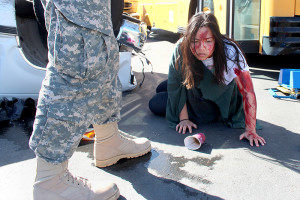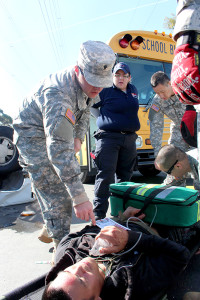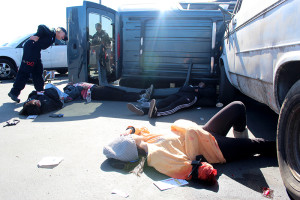Massive Emergency Response Exercise Conducted in Fremont

wounds of many different types, participated in
Operation Rolling Chaos, a simulated mass casualty
disaster exercise.
A dozen cars lay in a heap of twisted metal on the road, the result of a natural disaster. Sprinkled here is shattered glass; peppered there, are people – bloody, mangled, and wailing.
“Help! Please help!” a female voice screams through the window of an old white van. Her passenger lays face down on the dashboard. This scene is reproduced in each of the dozen cars within the pile-up, creating a horrible chorus of moaning that repeats, “Someone please help!”
Answering her call are dozens of first responders from various organizations. Some are wearing the dark blue of paramedics, others the green camouflage of the military. All are frantically working to save the survivors of this terrible calamity.
“She’s got a laceration on her stomach, I need an evac!” a young medic calls out, kneeling over a young woman on the road. A group of soldiers run up and place her on a stretcher. “One, two, three, lift,” the leader says, and they are off.
Normally, victims of such a disaster would be taken to a hospital where they would be treated for their wounds; some would survive and others wouldn’t. But this is only a simulated mass casualty exercise; there are no wounds to be treated; everyone will survive.
This is Operation Rolling Chaos, a drill conducted Sunday to practice life saving techniques and test the lines of communication between civilian and military first-responder units in natural disasters.
 “This is the first time we’ve had the National Guard, a private institution, ambulance companies, sheriff and everybody together, to function as one unit,” says Colonel Anthony Dintcho of the California State Military Reserve, which had two units participating in the event.
“This is the first time we’ve had the National Guard, a private institution, ambulance companies, sheriff and everybody together, to function as one unit,” says Colonel Anthony Dintcho of the California State Military Reserve, which had two units participating in the event.
Hosted by the privately run Unitek College in Fremont, Rolling Chaos featured nearly 400 participants from the National Guard, local ambulance companies, the Fremont police and fire departments, and Unitek students.
The simulation was based on a 2009 report from the Santa Clara Valley Water District that warned a 6.6 magnitude earthquake could cause the Anderson Dam near Morgan Hill to break, unleashing a 35-foot wall of water on the nearby town.
To aid in the reality of handling such a disaster, 12 cars, one bus, and nearly 200 live “victims” were brought in, served by eight ambulances, two helicopters, and scores of civilian and military lifesavers.
During recent disasters, such as Hurricane Katrina, rescue efforts were impeded by lack of communication between the military and local civilian departments, according to Eli Soto, senior vice president of Unitek and chairman of the Alameda County Veterans Committee.
“That’s what we’re really trying to address: communication between different agencies,” explains Soto. “The more practice you have, the better you are in understanding the whole dynamic.”
 On the military side of that dynamic was the all-volunteer California State Military Reserve for northern California, lead by Colonel Anthony Dintcho, who claimed his units could respond to a disaster in up to an hour.
On the military side of that dynamic was the all-volunteer California State Military Reserve for northern California, lead by Colonel Anthony Dintcho, who claimed his units could respond to a disaster in up to an hour.
“Now here, you have civilians, you have students, you have the state military reserve, you have a one star general, and the local sheriffs and fire department,” said Dintcho. “You turn around and all of a sudden they’re all here. In a real situation that’s what’s gonna happen. And everyone’s gonna have to get along.”
Rep. Eric Swalwell observed the simulation and said he wanted to see how the local agencies were preparing for natural disasters; Swalwell was recently appointed to the House Homeland Security Committee.
“The dedication to the cause is pretty impressive,” said Swalwell over a shrill chorus of wailing participants. “I just know from everything I’ve done, whether its college athletics or academics that it takes practice, practice, practice, and you hope that over time the hours of practice make you ready for when something like this happens.”














